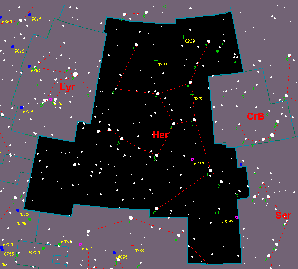
![[de]](../../Logos/flag_ger.gif)
![[it]](../../Logos/flag_it.gif)
Particulars:
General:
This northern constellation is not very conspicious but the fifth largest in
the sky. The northern boundary runs close to DECL=50 degrees, the southern
streches with DECL=4 degrees nearly down to the celestial equator. The
west-east extention starts at RA=15h 50m and nearly reaches RA=19h.
The four stars epsilon Her, zeta Her, eta Her and pi Her form the
asterism Keystone.
Hercules seems to be kneeling on the head of
Draco. His outstreched hand is
holding a bow and the arrow Sagitta
is flying towards the two birds, the Eagle,
Aquila and the Swan,
Cygnus.
The greek word for the complete form is Kornephoros.
Stars and other objects
The leading star alpha Her, called Ras Algethi (arab.:
kneeler's head), is a red supergiant (spectraltype M5Ib-II). Its brightness
varies erratically from 3.1 mag to 3.9 mag. A small telescope reveals a second
star of 5.39 mag (physically not related to the other). This 'companion' is
a binary consisting of a G5 giant and a F2 main sequencec star (not resolvable
by amateur scopes).
The brightness of the variable star S Her varies every 307 days from 5.9
mag to 13.6 mag. It belongs to the same class of variable stars as R Ser.
The varibale star SZ Her is a eclipsing binary. Every 16 hour the fainter
component dims the brighter from 10.2 mag down to 12th mag. The eclipse has a
duration of about 90-100 minutes. Tom Polakis observed this star and printed a
lightcurve. See more details at
his page.
The double zeta Her (a 10157) has a period of 34 years.
An easy object for small telescopes is kappa Her. The two stars are a
G8III of 5.00 mag and a K1III of 6.25 mag.
Also resolvable in small scopes is the pair rho Her, an A0 main sequence
star of 5.47 mag and a B9.5 III star of 4.52 mag.
The binary u Her consists of a B1.5Vp and a B5III star. The system
appears to the naked eye as a star of 4.82 mag.
An attractive pair to observe with small telescopes is 95 Her; two
stars of 5th mag shining in a golden and silver light.
One of the most beautiful globular clusters in the sky is
M13, the famous Hercules
Cluster. To the naked eye it is visible as a star of 4th mag. In
smaller telescopes it appears as a misty patch being more dense towards the
center. Large scopes reveal a nearly perfect sphere of stars.
Although nearly a magnitude fainter M92
is still an interesting object for smaller scopes.
NGC 6229 is a faint globular cluster - compared to the other two. Its
brightness is just of 10th mag.
The planetary nebula NGC 6210 shows a quite bright inner ring and a
faint outer ring. The apparent dimension of the latter is 20''x43''.
The next object is not visible with amateur telescopes: Hercules X1
together with Cygnus X1 is probabaly the most studied X-ray source. The
spectrum of Hercules X1 shows a periodicity of tau=1.2378 sec;
within this interval the star finishes one revolution around itself. This is a
typical value for pulsars - fast rotating neutron stars. A second periodicity
has been discovered: each 1.7 days the signals stop. So obviously Hercules
X1 is part of a double star. In September 1970 the primary star could be
located: its HZ Her. This system lies in a distance of about 20000
lightyears from us. Its mass of Hercules X1 has been determined to be
0.9 +/- 0.4 solar masses.
From May, 19th, to June 19th, the meteor shower
Tau Herculids is active.
On June, 9th, the maximum occurs with about 4 meteors. See Gary Kronk's
database of meteor showers for details.
Mythological Background:
In the mythology of the ancient Greeks Hercules has been the son of Godfather
Zeus and the Alkmene, the wife of Amphitryon. Zeus made Alkmene believe thar he
was Amphitryon.
Of course, Hera, the wife of Zeus, was not very pleased by this; somehow she
managed that Eurystheus was the first born son of Alkmene. This son gave this
half brother twelve tasks to solve:
to strangle the Lion of Nemea,Because all this has to be done because Hera wishes so (to perish Hercules, not to make him famous); yet his greek name was "Heracles", meaning "the man becoming famous through Hera".
to kill the Hydra,
to catch the hind of Diana,
to kill or chase the Stymphalion Birds,
to bring the boar of Erymanthes to Mykene alive,
to defeat the bull of Kreta,
to clean the Augias stable,
to tame the maneating horses of king Diomedes,
to get the arms of the Hippolyta,
to get the cows of the giant Geryon,
to pick the apples in the garden of the Hesperides (well, it was Atlas who picked them while Hercules carried the heaven),
to get Zeberus, the three-headed dog of the Hades (hell)
(Ovid, Metamorphoses, IX,2).
![[Constellations]](../../Logos/constS_s.gif)
![[Home]](../../Logos/maa_s.gif)